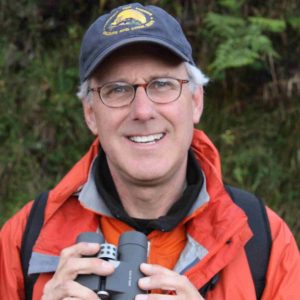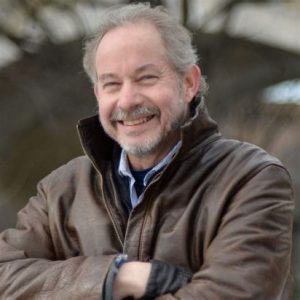Michael Jenkins:

I am here with Dr. Bruce Beehler, who is a research associate at the Smithsonian’s National Museum of Natural History. We first met in 1991 in the highlands of Papua New Guinea looking for birds of paradise. Prior to his retirement, he worked at the Wildlife Conservation Society and Conservation International. He is also an expert ornithologist. He’s authored many books, and recently, has been writing about how biodiversity is appearing in our lives during the COVID-19 pandemic and what that really means.
Bruce, what I would like to talk about today is the idea of resilience and biodiversity. The piece you wrote for the Washington Post was perfect because I think many of us have been having similar conversations with people about wildlife sightings during the pandemic. “I’m seeing all this wildlife that I’ve never seen before.”
What do all these sightings during the pandemic really mean in the bigger picture?
Bruce Beehler:

We really need to reconnect with biodiversity. We have deer in the backyard now, but they’ve always been there, not just during this pandemic. I think we just haven’t been seeing them.
Michael Jenkins:
To me, it seems like we are seeing these snapshots that are so beautiful, but the outlook for biodiversity is still a gloomy one. You took a trip recently to track migrating birds. Could you share a little about that trip and what it left you with in terms of the bigger picture for biodiversity?
Bruce Beehler:
I went the whole length of the Mississippi River, following birds during spring. I started in eastern Texas and southern Louisiana and I followed the river to its headwaters, and then continued northward into Ontario as far as I could drive.
What I saw was something fantastic. Hundreds and hundreds of green spaces, beautiful protected areas – some local, some county, some state, some federal. Some were provincial in Canada. Wonderful, hundreds of millions of acres that were protected. I camped in all these places. I saw bears and moose and wolves. I saw indigenous people living in these places. I saw local people who were fishing and bird watching and reveling in nature.
You think of the middle of America as being mainly corn fields and things like that. But there are still many, many places like the ones I visited, especially close to the Mississippi. Wonderful places that you didn’t know existed are there because of local community action or state or federal action. It was really uplifting to see.
Michael Jenkins:
So, to capture a piece of what you’re saying: given a chance, biodiversity can be quite resilient. It can bounce back. What we’re seeing recently in our backyards is a signal from nature about resilience. A signal that we need to be paying attention to, and thinking of the next steps.
Bruce Beehler:
Hear, hear!
Michael Jenkins:
At Forest Trends, we’ve always focused on ecosystem services and functions and encouraged others to think of them as fundamental to all life, including us, rather than thinking of nature as separate from us, or something we find only in protected areas.
At our ten-year anniversary celebration at Forest Trends, Al Gore came to speak, and we were able to talk for a little while.
I was describing our work to Al Gore, and he says, “Climate is the envelope of all of this.” And it really struck me because I had always thought of climate as an ecosystem function. I’ve been thinking about that analogy a lot lately. If climate is the envelope, biodiversity is the letter in the envelope. And if you follow my thinking there, what would that letter say?
Bruce Beehler:
At the moment, the letter would say “Oh my gosh, ouch! The envelope is on fire! Humankind and their activities have constricted the envelope and made it smaller and smaller.”
The analogy is an apt one. I think both climate and biodiversity face a similar challenge. They are hard-to-grasp ideas for normal people on the street. You can’t hold on to climate, you can’t touch it. That’s why I think conservation organizations shouldn’t forget about the wildlife story. That resonates with people. People connect more easily to things like the plight of the tiger in India.
Michael Jenkins:
A few months ago, there was a huge wave of interest and support around climate. We were seeing this from a lot of unusual actors, such as Blackrock, Microsoft, Amazon, Rio Tinto, and Shell, and all these groups said, “We need to think about climate and offsets and nature-based solutions and forests.” All of that has created a financial engine, if you will, where there’s going to be a lot of money invested in climate.
There has been a parallel COP for biodiversity, but the truth is, it lacks the same kind of engine – there’s no 1.5-degree target, no carbon market, no concrete way to generate the same kinds of scalable resources directed at climate issues. What do you think the frame needs to be for biodiversity to get that support and attention?
What can we do now that’s going to start to make a difference there – all of us?
Bruce Beehler:
At the end of the day, I really think it’s going to be people. With the technology we have now, I can talk to someone in Sweden today and see their face and actually make a decision. Somehow, we need to break down those walls and connect and act together.
I also think it really has to be communities doing the work. That’s part of the reason I write about North America now. Because that’s my community. We really need to come home. All of us.
Maybe we ought to have something like a new Peace Corp where groups go out into the countryside, in the US or elsewhere, and help communities re-green their environments.
Michael Jenkins:
To shift and bring us back home, what have you been seeing lately that gives you hope for biodiversity? People are having all these wildlife sightings. What has your experience been?
Bruce Beehler:
Every morning I go on an 18-mile bike ride out the C&O Canal path to Great Falls Park and do an audio bird survey. I upload what I hear to eBird, which is Cornell’s global bird database. Hundreds of millions of data on birds from around the world.
What I see now is the height of spring — it’s absolutely glorious, it’s beautiful, it’s very invigorating, it’s the highlight of my day. And every day I stop to check on a bald eagle nest and see new birds that are arriving from the tropics, whether it’s a Northern parula warbler or Louisiana waterthrush.
Where you and I live on the Potomac River has beautiful green spaces, and you see the result of setting up C&O Canal National Park. You and I and others can go every day and commune with nature. There was a bobcat photographed recently out there, that’s new. Black bears, coyotes also live there. So, it’s wonderful. That system works – at the local level we know we can get it right.
Michael Jenkins:
What small but practical things would you advise people to do for nature and biodiversity from home right now as they shelter in place with their families? Whether it’s writing your congressperson or setting up habitats in your yard, such as bat houses.
Bruce Beehler:
People can start in their back yards, making them more wildlife friendly. It doesn’t take a lot to achieve this. There are websites (Audubon, National Wildlife Federation, Cornell Lab or Ornithology) that provide guidance. Then they can volunteer at a nearby park. Or do like you do, Michael, and plant native tree species in openings.
This kind of physical work produces a lot of joy. When people get their hands on the earth and are doing this, they will fall in love with their work and what they see. That might begin to inspire other actions on the behalf of the natural world.
Michael Jenkins:
I’m actually seeing that with folks in my neighborhood – we are working in the woods together. There’s just nothing more satisfying than taking English ivy off of old oaks, and there’s nothing more satisfying than watching a seedling that you plant become a 10 ft tree on its way to becoming a 200-year-old, 100 ft tree. It’s an amazing thing.
It’s unbelievable when we can do that, even on a small scale. And like you said, maybe a new Peace Corp-like effort focused on restoring ecosystems could be a way to start collectively acting, even if we’re far apart.
Bruce Beehler:
Earth Corps! A global Earth Corps. There are hundreds of volunteer organizations out there already, but they’re not big enough. We need to scale them up!
Michael Jenkins:
Do you have any final thoughts on resilience? Or our capacity to come up with solutions to some of the obstacles we’re facing?
Bruce Beehler:
Well, to me, the resilience we want to see goes hand in hand with planting trees and regreening or revegetating land. There is so much “waste land” around the world. There are many little things, like replanting natural hedgerows surrounding agricultural fields, that we can do that start to add up with regard to climate change and biodiversity loss. Every tree counts and it’s got to be done by regular people – local groundswells that grow and make a real difference.
Viewpoints showcases expert analysis and commentary from the Forest Trends team.
Connect with us on Facebook and Twitter to follow our latest work.
